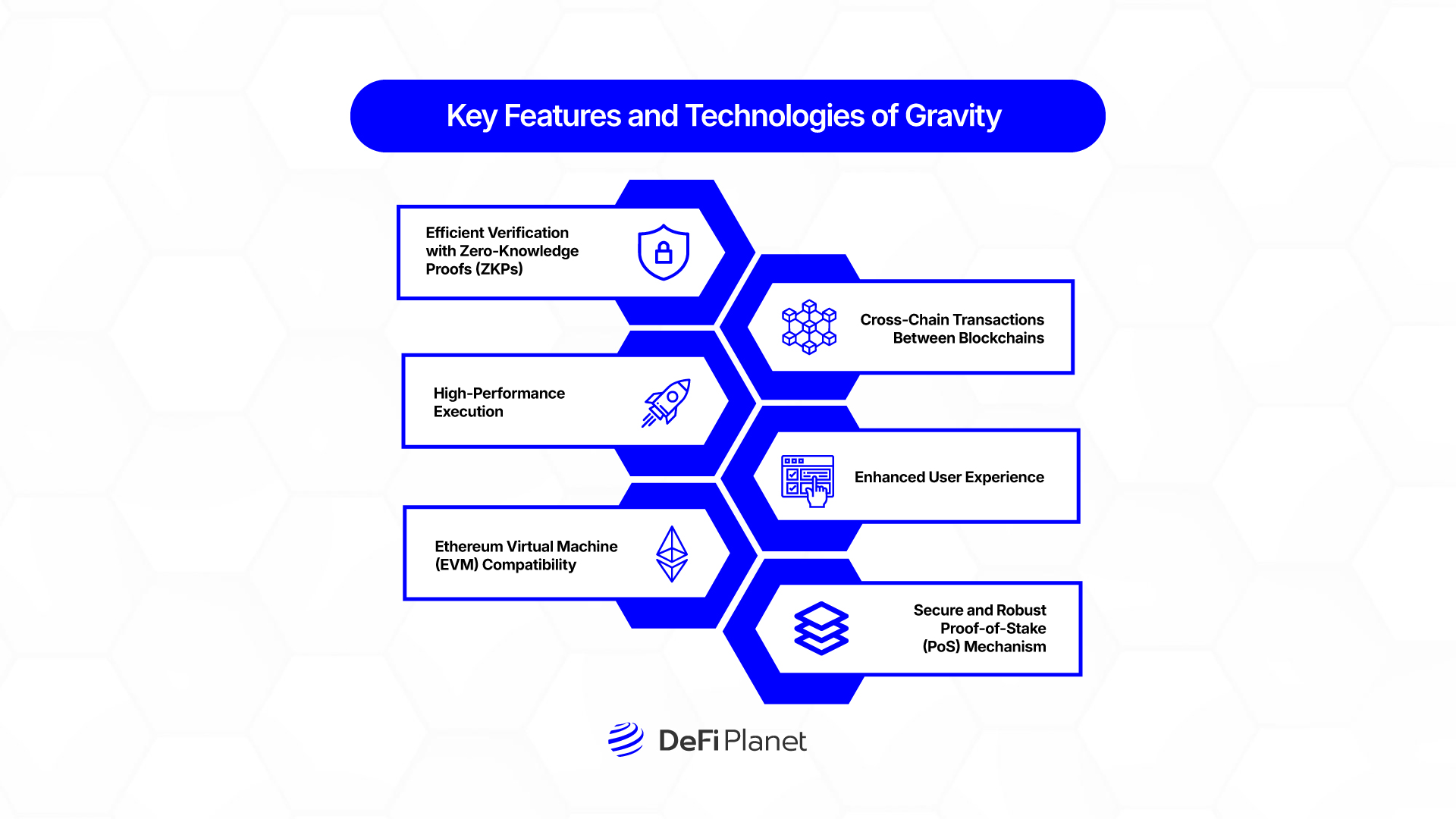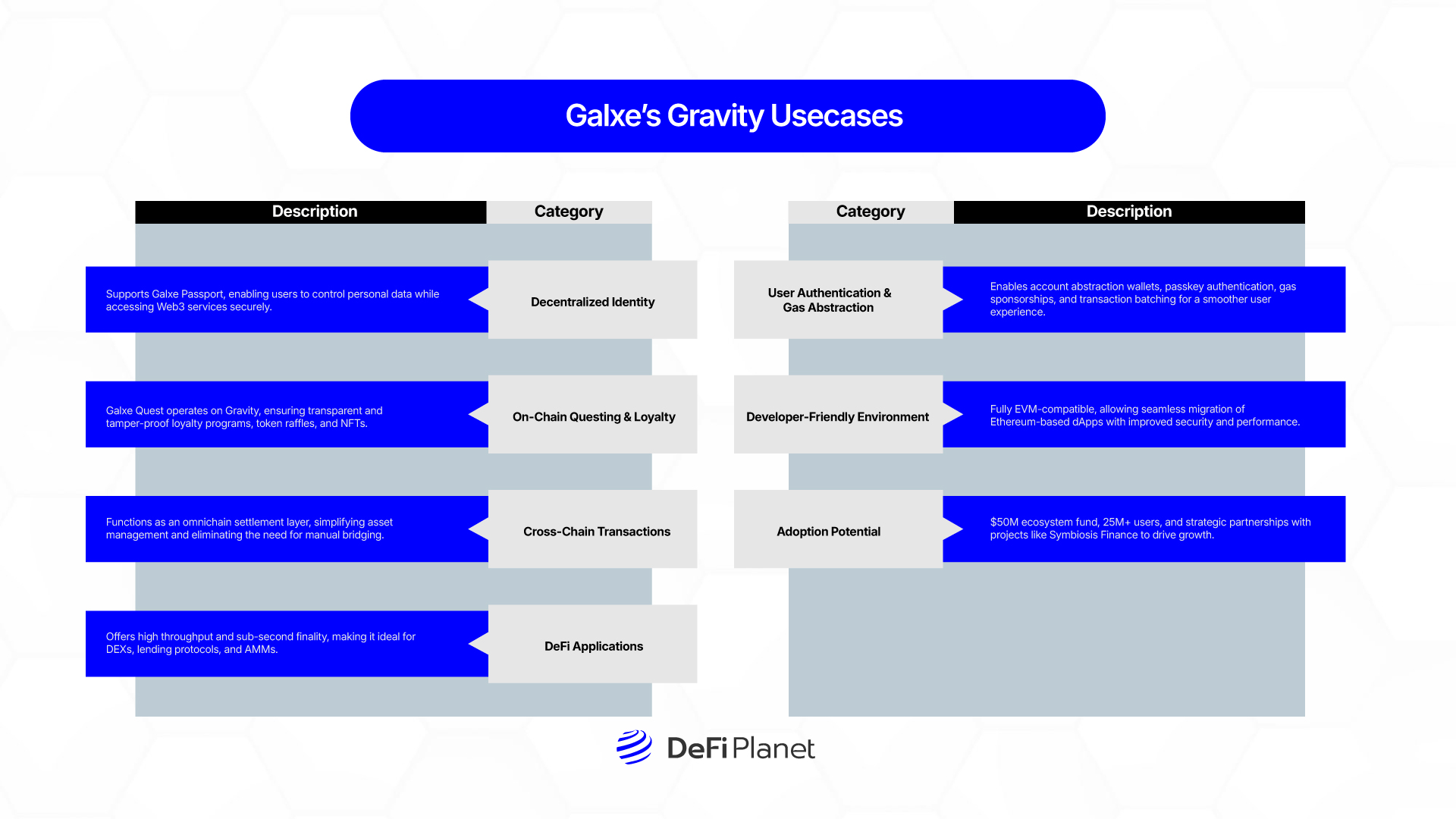The speedy progress of Web3 has created a urgent want for scalable, environment friendly, and user-friendly blockchain infrastructure. Current networks usually battle with excessive charges, sluggish transaction speeds, and restricted interoperability, making it tough for tasks to scale and for customers to have interaction seamlessly throughout a number of platforms.
To deal with these challenges, Galxe launched Gravity, a high-performance Layer 1 blockchain constructed to assist decentralized purposes and credential-based programs. Gravity improves knowledge integrity, streamlines credential verification, and enhances interoperability throughout Web3.
On this article, we discover how Gravity works, what issues it solves, and what makes it best-suited to unravel them. We additionally level out the issues it doesn’t clear up and those it would create. Let’s get to it.
How Galxe’s Gravity Works
Galxe’s Gravity is a purpose-built Layer 1 blockchain designed to energy a extra environment friendly and interoperable Web3. Constructed with pace, id safety, and cross-chain capabilities in thoughts, it serves because the infrastructure layer underpinning Galxe’s rising suite of credential-based and engagement merchandise.
It operates on a Jolteon Consensus, a customized Proof-of-Stake (PoS) mechanism that permits sub-second transaction finality whereas sustaining decentralization.
At its core, Gravity combines a number of technical parts. It leverages Zero-Data Proofs (ZKPs) to confirm info with out exposing delicate knowledge. This cryptographic technique reduces the computing burden of transaction validation whereas sustaining robust safety—best for data-heavy dApps and id companies.
Gravity is absolutely EVM-compatible, permitting builders to deploy and work together with present Ethereum-based good contracts with out in depth modifications. It extends this compatibility with the Reth Execution Layer, an optimized Ethereum consumer that will increase throughput and reduces latency for dApp efficiency.
By combining these instruments, Gravity acts as each a high-throughput settlement layer and a connective tissue throughout blockchain ecosystems. Builders can set off transactions throughout a number of chains inside a single UX movement—with out counting on bridges or wrapping belongings.
Gravity’s native token is named $G and since it’s a PoS system, holders can stake the token to assist safe the community whereas incomes rewards. However it doesn’t cease there. Gravity additionally integrates with restaking protocols like Babylon and EigenLayer, permitting customers to stake their tokens throughout a number of safety layers. This method not solely strengthens the community but additionally unites a various group of validators, making the chain extra resilient towards assaults.

What Makes It Totally different and What It Gives the Ecosystem
Whereas many Layer 1s tout efficiency or interoperability, Gravity packages these with a credential-native id layer—positioning itself not simply as a transactional chain, however a service hub for actual Web3 utility.
Right here’s what units Gravity aside:
Native Cross-Chain Performance
In contrast to conventional Layer 1s that depend on third-party bridges, Gravity permits multi-chain execution as a first-class function. This simplifies asset flows and dApp logic for builders, decreasing assault surfaces and technical debt.
It has integrations with protocols like Symbiosis Finance and different chains like Soneium to assist superior cross-chain performance.
Constructed-in Id Infrastructure
With Galxe Passport built-in on the base layer, Gravity presents privacy-respecting id primitives out of the field. This unlocks on-chain credential verification, loyalty programs, and real-world fame mechanics—all with out requiring customers to dox themselves.
Blockchain wallets could be tough to make use of, usually requiring lengthy seed phrases for safety. Gravity enhances consumer expertise by supporting cryptographic primitives just like the secp256r1 curve by way of precompiled contracts.
In easy phrases, this enables customers to log in and authenticate utilizing passkeys as a substitute of sophisticated pockets passwords. It additionally improves Account Abstraction wallets, making crypto transactions really feel as seamless as utilizing an everyday on-line account.
Improved UX with Fuel Abstraction
Gravity lets builders sponsor gasoline or batch transactions, so customers don’t have to fret about holding a number of tokens. This lowers the friction for onboarding and helps Web2-like experiences that mainstream customers count on.
Seamless Developer Onboarding
Gravity is EVM-compatible, which implies Ethereum builders can migrate apps or construct new ones with minimal adjustments. Mixed with quick finality and excessive throughput, it gives a low-barrier, high-reward atmosphere for builders.

The Issues It Doesn’t Clear up—and the Ones It May Create
Gravity isn’t a silver bullet. Whereas it addresses core challenges in cross-chain infrastructure and consumer expertise, it additionally introduces new questions round scalability, safety, and fragmentation.
It Doesn’t Remove Layer 1 Redundancy
Web3 is already crowded with high-performance chains. Established platforms like Ethereum dominate good contract execution, whereas Layer 2 options comparable to Arbitrum and Optimism present cost-effective options.
Gravity might supply refinements—nevertheless it enters a saturated area the place chains like Solana, Avalanche, and Sui already promise pace and scale. With out a killer utility or novel financial incentive, it dangers turning into “simply one other chain.”
Efficiency vs. Resilience
Sub-second finality and 1 gigagas/second throughput are spectacular—on paper. Excessive transaction speeds and seamless cross-chain execution require sturdy infrastructure. So sustaining these speeds at scale, with real-world demand and a number of rollups, can introduce bottlenecks or validator dangers. Any lapse in efficiency or downtime may harm belief early on.
Validator and Restaking Complexity
Gravity goals to safe itself by way of $G staking and integrations with restaking protocols like EigenLayer or Babylon. Whereas this provides redundancy, it additionally creates dependencies on exterior programs which are nonetheless evolving—and themselves unproven at scale.
UX Enhancements Depend on Adoption
Passkeys, gasless transactions, and simplified onboarding all rely upon developer integration and pockets compatibility. With out full ecosystem buy-in, these options danger being underused or erratically distributed throughout dApps.
Regulatory and Id Tradeoffs
Dealing with credentials and id on the chain degree introduces a regulatory gray zone. Though Galxe Passport is privacy-first, the affiliation with verified id knowledge may draw consideration from regulators—particularly in jurisdictions with knowledge privateness legal guidelines.
Safety Issues
Safety is one other main concern. Blockchains dealing with delicate credential knowledge and monetary transactions have to be resilient towards exploits, hacks, and malicious actors. Any vulnerabilities in Gravity’s consensus mechanism or good contract execution layer may result in safety breaches, lack of funds, and reputational harm. Gravity should implement rigorous safety measures and endure common audits to mitigate these dangers.
Can Gravity Shift the Infrastructure Panorama?
Gravity represents a pointy pivot from generalized blockchains towards purpose-driven infrastructure. By specializing in credential-native id, seamless UX, and omnichain interoperability, it targets the long-underserved want for higher knowledge, smoother onboarding, and composability throughout ecosystems.
Its strongest benefit? Galxe’s present traction. With thousands and thousands of customers already engaged in quests, loyalty programs, and ID instruments, Gravity doesn’t want to begin from scratch. It might immediately supply actual utility and suggestions loops, making it greater than a theoretical chain.
Galxe has launched a $50 million ecosystem fund to assist builders in constructing user-centric purposes and subsidiary blockchains on Gravity.
Galxe has additionally dedicated a $50M fund to assist builders in constructing user-centric purposes and subsidiary blockchains on Gravity. It’s uncommon for a brand new chain to launch with each funding and a dwell consumer ecosystem.
However success will hinge on execution. If Gravity can keep its technical edge, win over builders, and ship true multi-chain experiences with out compromising safety, it may play a significant function in shaping Web3’s subsequent section.
Gravity received’t change Ethereum or Solana, nevertheless it doesn’t have to. Its doubtless future is as a middleware layer that powers id, engagement, and credential verification throughout chains. In a world of fragmented chains and disconnected UX, that’s a job price betting on.
Disclaimer: This text is meant solely for informational functions and shouldn’t be thought-about buying and selling or funding recommendation. Nothing herein ought to be construed as monetary, authorized, or tax recommendation. Buying and selling or investing in cryptocurrencies carries a substantial danger of economic loss. All the time conduct due diligence.
If you want to learn extra articles like this, go to DeFi Planet and comply with us on Twitter, LinkedIn, Fb, Instagram, and CoinMarketCap Group.
Take management of your crypto portfolio with MARKETS PRO, DeFi Planet’s suite of analytics instruments.”
The publish Web3 Infrastructure Wars: The place Does Galxe’s Gravity Slot in? appeared first on DeFi Planet.


